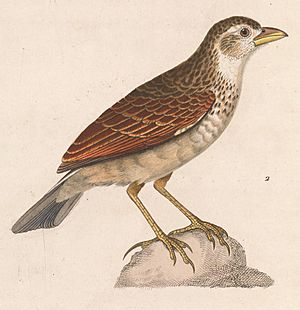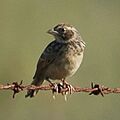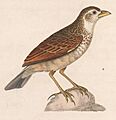Horsfield's bush lark facts for kids
Quick facts for kids Horsfield's bush lark |
|
|---|---|
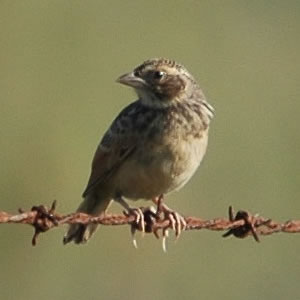 |
|
| Conservation status | |
| Scientific classification | |
| Genus: |
Mirafra
|
| Species: |
javanica
|
| Subspecies | |
|
See text |
|
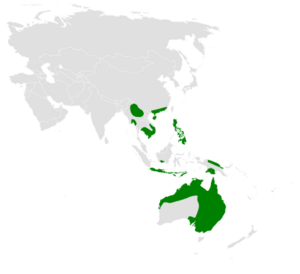 |
|
The Horsfield's bush lark (Mirafra javanica) is a type of lark bird. It lives in grasslands across most of Australia and a large part of Southeast Asia.
Contents
About the Horsfield's Bush Lark
The Horsfield's bush lark is one of about 90 different kinds of larks. Larks belong to a large bird family called Alaudidae. These birds are small to medium-sized passerines, which means they are perching birds. They usually have dull, brownish feathers. Most larks live in the Old World (Europe, Africa, and Asia). However, the Horsfield's bush lark is the only one found naturally in places like Wallacea, New Guinea, and Australia.
People sometimes call this bird by other names, like "bush-lark" or "Australasian bushlark." It can also be called the "Australasian lark," "Australian lark," "eastern bush lark," "eastern lark," "eastern singing bush lark," "Horsfield's lark," or "Javan lark."
Different Types of Horsfield's Bush Larks
There are 16 known types, or subspecies, of the Horsfield's bush lark:
- M. j. williamsoni: Found from central Myanmar to southern China, Thailand, Cambodia, and Vietnam.
- M. j. philippinensis: Lives in the northern Philippines.
- M. j. mindanensis: Found in the southern Philippines.
- M. j. javanica: Lives in Borneo, Java, and Bali.
- M. j. parva: Found in the western Lesser Sunda Islands.
- M. j. timorensis: Lives in the eastern Lesser Sunda Islands.
- M. j. aliena: Found in northern and north-eastern New Guinea.
- Cinnamon lark (M. j. woodwardi): Lives in the far north-western part of Western Australia.
- M. j. halli: Found in northern Western Australia.
- M. j. forresti: Lives in north-eastern Western Australia.
- M. j. melvillensis: Found on Melville and Bathurst Islands (near northern Australia).
- M. j. soderbergi: Lives in the northern Northern Territory (northern Australia).
- M. j. rufescens: Found in central Australia.
- M. j. athertonensis: Lives in north-eastern Australia.
- M. j. horsfieldii: Found in eastern and south-eastern Australia.
- M. j. secunda: Lives in south-central Australia.
What the Horsfield's Bush Lark Looks Like
The Horsfield's bush lark is a small, sturdy bird with a big head. It has a short, sparrow-like beak and a small crest of feathers on its head that only shows when it raises it. Its back feathers are brown, reddish, or sandy, with darker stripes in the middle. Its chest has spots or streaks, and it has a light brown stripe above its eye. The underside of its body is pale, and its tail is brown.
Adult birds have crowns and upper parts that are almost black, with rough light brown to reddish-brown streaks. Young birds look similar, but their crowns and upper parts have neat white edges on their feathers. Baby birds have soft, thick down feathers and dark spots on their tongue and inside their mouth.
These birds are usually about 61–81 mm long from wingtip to wingtip, and their tails are 40–56 mm long. Their beaks are 12–16 mm long, and they weigh about 18-25 grams. Their wings are short and round, with a clear reddish-brown patch.
Similar Birds
The bush lark looks very much like the Australasian pipit and can also be mistaken for a young Eurasian skylark. When flying, the bush lark's wings do not have the white edge that the skylark's wings do. Its tail has white sides, like the skylark and pipit, but it is only half as long.
You can usually tell a bush lark by its body shape and the reddish-brown patches on its wings. However, these colors can fade to a lighter buff color. When a bush lark is startled and flies away, it makes a soft chirping sound. Its flight style is also a good clue: it flies with jerky wing beats, its head slightly up, and its tail down. Before landing or dropping into cover, it will briefly hover or flutter.
In contrast, the Australian pipit stands more upright, is slimmer, and has a thinner beak. It walks with purpose on its long legs. When standing, the pipit constantly bobs its tail. When it flies, it drops into cover without hovering.
Where Horsfield's Bush Larks Live
The Horsfield's bush lark lives in a very large area, covering about 10,000,000 square kilometers around the world. In Australia, you can find this bird from the Eyre Peninsula in South Australia, through Victoria, New South Wales, Queensland, Northern Territory, and Western Australia all the way to Shark Bay.
These birds move to south-eastern Australia during the summer. They are sometimes seen in Tasmania, but not often. In Australia, they live in areas with chenopod shrubs, native and non-native grasslands in warm and tropical places, coastal heathlands, sand dunes, and mudflats. They also live in changed open areas like farms and pastures. You might see them less often on sports fields, golf courses, roadsides, salt marshes, or other shrublands. They rarely live in areas with many trees.
Life and Habits of the Horsfield's Bush Lark
Reproduction and Nesting
In Australia, bush larks are known to breed after a lot of rain in dry areas. During the breeding season, they protect their territory. Both parents help to incubate (sit on) the eggs and feed the baby birds (nestlings and fledglings). They also remove waste from the nest.
Young birds stay in the nest for up to 12–14 days or even longer. But if something disturbs them, they might leave the nest when they are only 7–8 days old, even before they can fly well. They depend on their parents for almost a month after they leave the nest. Sadly, many nests are not successful, mostly because of predators like introduced mammals.
An interesting old story from 1865, written by Edward P. Ramsay (a bird expert), describes how these birds build their nests. He said that the nests of Mirafra javanica horsfieldii are usually found from November to February. They are messy, cup-shaped nests made only of grass, without a special lining. The birds make a small hollow next to a clump of grass or behind a lump of dirt. The front edge of the nest is smooth, but the back is left messy, sometimes pulled forward to hide the eggs. The nests are about 28 inches wide and 1 inch deep. On February 4, 1861, a nest was found in a hay-field with three eggs, which is the usual number. The eggs were light earthy brown with many darker freckles.
Vocalisation (Singing)
During the breeding season, bush larks sing any time of day or night. They sing from the ground, low perches, or while flying high over their territory. The bush lark can sing a beautiful, long song. This song often includes very good mimicry of other bird species. In the 1930s, someone noted that the lark might remember calls or "steal" them from other birds that mimic. For example, it could sing the "tink, tink" sound of the Brown treecreeper, even if that bird no longer lived in the area. This meant the lark either heard the sound during its travels or learned it from another bird that could mimic.
Feeding Habits
Bush larks live on the ground and eat both plants and animals (they are omnivorous). They have a short, strong beak that is good for crushing seeds. They mainly eat grass seeds and small creatures without backbones, especially insects during the breeding season. They find most of their food by picking it up from the ground surface or just below it. They usually look for food alone, but sometimes they are seen in small groups.
Images for kids
See also
 In Spanish: Mirafra javanica para niños
In Spanish: Mirafra javanica para niños




